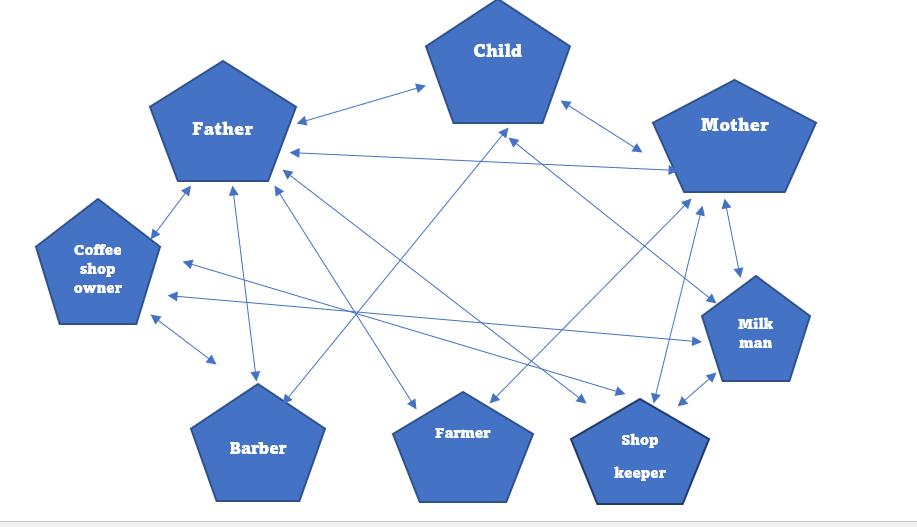January Activity – We Are Community
EXPECTED OUTCOMES
- To show the interdependence that exists in our society
- To make students aware about the interdependence and its importance in their own life
- Skills – Analytical skill, Team Spirit, and Communication skills.
SESSIONS’ OVERVIEW
| S. No. | Session Details | Estimated Time Required |
| 1 | Debrief of last session
Step 1 - Introduction Step 2 -Planning & activity Step 3 – Instructions for homework |
45 Minutes |
| 2 | Step 4: Group Activity
Step 5: Debrief Step 6: Reflection sheet and Feedback form |
45 Minutes |
MATERIAL REQUIRED
10 balls of string or yarn, preferably multi coloured, chart paper, name tags
STEPS OF THE ACTIVITY
SESSION-1
Estimated time required: 45 minutes
Step 1 Introduction –
We are in contact with many people in our day-to-day life. There are some people who directly help us, but do you know there are people whom we actually do not know in person but, still we are benefitted by them. Are you curious to know? Let us play a small game to understand this interdependence that exist in community and how various people benefit us in some way or the other.
Step 2 Planning & Yarn activity –
- Explain the group about the activity, do not disclose the outcome/purpose of the activity at the beginning.
- Ask the students to make a list of people they see as a part of their society: farmers, children, teachers, parents, drivers, house cleaners, grandparents, construction workers etc.
- Give each child one of the roles and have them write it on a name tag.
- Students stand in a circle with the end of their ball of yarn tied around their waists.
- Students must now try to discover links between themselves and other players. For example, the farmer might depend on the construction worker to build her a new house or farm and the construction worker might depend on the farmer to produce food for him to eat. Students must figure out how each is dependent upon the other.
- Once they have agreed on this dependence, they should pass their balls of wool to each other, showing the connection.
- While throwing the yarn they need to say loudly, I am a student and I depend on my teacher for learning (By throwing yarn ball to teacher) and so on.
- Try not to exchange the yarn balls more than 2 times between 2 players to make and realize more connections in social circle.
- Try to create as many connections as possible in this web. Support the group to be creative to come up with some of the links.
- Take a few moments to discuss which of the players had the most connections, why it is important to know that we are connected and dependent on others in our home, school, society, and city and in our country.
- At the end, the teacher will ask the students to cut the web. While doing so, the teacher can tell the students to be observant to the complexity in the way we relate to each other in our day-to-day life.
- The teacher can also ask which connections are most critical, which are not and why.
Step 3 – Instructions for homework
Ask the students to observe their day-to-day connections in the community.
SESSION-2
Estimated time required: 45 minutes
Step 4: Group Activity
1. The teacher can begin the session by saying that, In the previous session we had made a web of our connections in the community. Remind them that the web was made with various chains. Then discuss with the student’s some community chains with as many roles as possible from their day-to-day life, like mother, father, teacher, barber, milkman, farmer, vendor, house cleaner, driver, businessperson, police, politician, lawyer etc. (with reference to the previous session).
2. The teacher can divide the students into 4-5 groups.
3. In each group, ask students to divide the chain into 3 segments- Extremely essential, Essential, can manage without them.
4. In groups, students will need to critically analyze the ways to become independent for their own work. They must discuss the connections where interdependencies can be minimized at student level.
5. The teacher can write on the blackboard to show an example: -


| Extremely essential | Essential | Can manage without them |
| Student-Mother-Father | Father- Friend | Friend-Barber |
6. Give 10 minutes to discuss in the group.
7. After that, call groups one by one to share their views on how students can minimize their interdependencies to become more independent in their daily life. Also, understand the importance of interdependence in their lives.
8. Students' groups can take 3-5 minutes for each presentation.
Step 5: Debrief
Teachers are requested to do a debrief session with all students with questions like-
- Why should we respect each other?
- What should we do to maintain the interdependence in healthy manner?
- How can we become in dependent/less dependent in younger age?
- What did we learn from this activity?
Step 6: Reflection Sheets & Feedback Form
Teachers to kindly fill in the feedback form and remind students also to fill up the reflection sheets.




